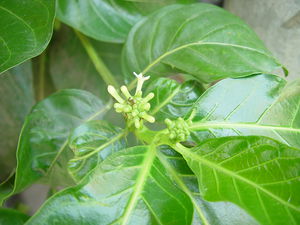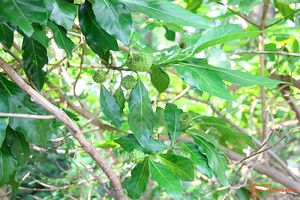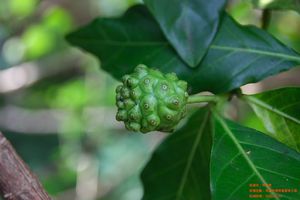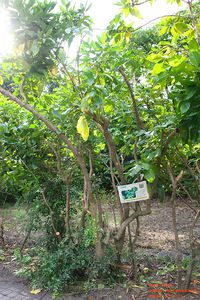檄樹
出自台灣有毒中草藥毒性資料庫
| 中英文學名 | 科別 | 毒性 | 症狀 |
基本資料
|
科別 | 茜草科 Rubiaceae |
|
屬名 | 羊角藤屬 Morinda |
|
中文學名 | 檄樹 |
|
拉丁學名 | Morinda citrifolia L. |
|
英文名稱 | Indian Mulberry, Noni, Great Morinda, ba ji tian, nono, cheese fruit, nhau |
|
中文俗名 | 海巴戟天 諾麗果 鬼頭果 紅珠樹 水冬瓜 樁根 |
植物圖片
|
檄樹1 |
檄樹2 | |
|
檄樹3 |
檄樹4 |
檄樹簡介
檄樹最主要的生長地方為南太平洋的群島上,或是一些熱帶地區[1]。主要是被當地居民用於治療疾病,近年來也被用於做為保健食品[2]。。
外觀簡述
|
莖 | 常綠小喬木,高可達7公尺,枝幹平滑,分枝鈍圓四方狀。 |
|
葉 | 單葉對生,具短葉柄,長約1.5-2公分。呈橢圓或長橢圓狀,長約10-30公分,寬約5-15公分,葉兩端均尖,葉全緣,正面呈深綠色,背面淺綠色,側脈8-11對。 |
|
花 | 花多數,白色,腋生頭狀花序,花序直徑2-3.5公分,單生,少數2-3枚叢生;花序梗1.5-2.5公分長,無毛,常與葉對生。花萼鐘形,長約0.2-0.35公分;花冠圓筒狀,長約1-1.5公分,先端五裂,冠喉有毛;雄蕊4-5枚,花藥線狀長橢圓,長0.25-0.3公分;花柱1-1.5公分,柱頭2裂。 |
|
果實 | 聚合果,球狀,大小約4-7公分,漿質,一開始為綠色,後轉為黃色,成熟時呈白色或黃綠色,種子多數。 |
產地
臺灣、東南亞、熱帶亞洲、澳洲及太平洋諸島。長於恆春半島和鄰近島嶼海濱。
毒性研究
1984年,Singh發表了一份研究指出諾麗果在早期多用於促進女性生殖能力,但在2009年歐洲食品安全局(European Food Safety Authority, EFSA)的一份針對諾麗果果汁的評估指出,EFSA並不贊同諾麗果有此種促進女性生殖健康[3]。其他的研究也指出,雖然在毒性評估實驗中,並沒有明顯的生殖毒性或是發育毒性,但仍有一些指標有出現異常,如分娩指數(parturition index),postimplantation losses[4]。 目前亦有案例報導顯示食入諾麗果出現肝臟損傷[5-7],其中有一案例最後必須進行肝臟移植,但仍須在更進一步的研究來證明諾麗果是否確實有肝臟毒性。 另外,由於諾麗果所含的鉀含量相當高,因此研究建議洗腎病患須避免攝食諾麗果,以避免加重腎臟負擔[8]。
- 中毒劑量
- 小鼠經由腹腔分別注射(intraperitoneally injection, IP)諾麗果水萃取及乙醇萃取液,半數致死劑量(medium lethal death, LD50)分別為7500 mg/kg及3500 mg/kg[9]。
毒性分級
參考文獻
1. Wang MY, Hurn J, Peng L et al. A multigeneration reproductive and developmental safety evaluation of authentic Morinda citrifolia (noni) juice. Journal of Toxicological Sciences 2011; 36: 81-85.
2. McClatchey W. From Polynesian healers to health food stores: changing perspectives of Morinda citrifolia (Rubiaceae). Integrative Cancer Therapies 2002; 1: 110-120; discussion 120.
3. Authority) EEFS. Opinion on the safety of Tahitian Noni® ‘Morinda citrifolia (noni) fruit puree and concentrate’ as a novel food ingredient. The EFSA Journal 2009; 998: 1-16.
4. Muller JC, Botelho GG, Bufalo AC et al. Morinda citrifolia Linn (Noni): in vivo and in vitro reproductive toxicology. Journal of Ethnopharmacology 2009; 121: 229-233.
5. Yu EL, Sivagnanam M, Ellis L, Huang JS. Acute hepatotoxicity after ingestion of Morinda citrifolia (Noni Berry) juice in a 14-year-old boy. Journal of Pediatric Gastroenterology Nutrition 2011; 52: 222-224.
6. Stadlbauer V, Fickert P, Lackner C et al. Hepatotoxicity of NONI juice: report of two cases. World Journal of Gastroenterology 2005; 11: 4758-4760.
7. Millonig G, Stadlmann S, Vogel W. Herbal hepatotoxicity: acute hepatitis caused by a Noni preparation (Morinda citrifolia). European Journal of Gastroenterology & Hepatology 2005; 17: 445-447.
8. Burrowes JD, Van Houten G. Use of alternative medicine by patients with stage 5 chronic kidney disease. Advances in Chronic Kidney Disease 2005; 12: 312-325.
9. Chearskul S, Kooptiwut S, Chatchawalvanit S et al. Morinda citrifolia has very weak estrogenic activity in vivo. Tahi Journal of Physiological Sciences 2004; 17: 22-29.
| 中英文學名 | 科別 | 毒性 | 症狀 |



